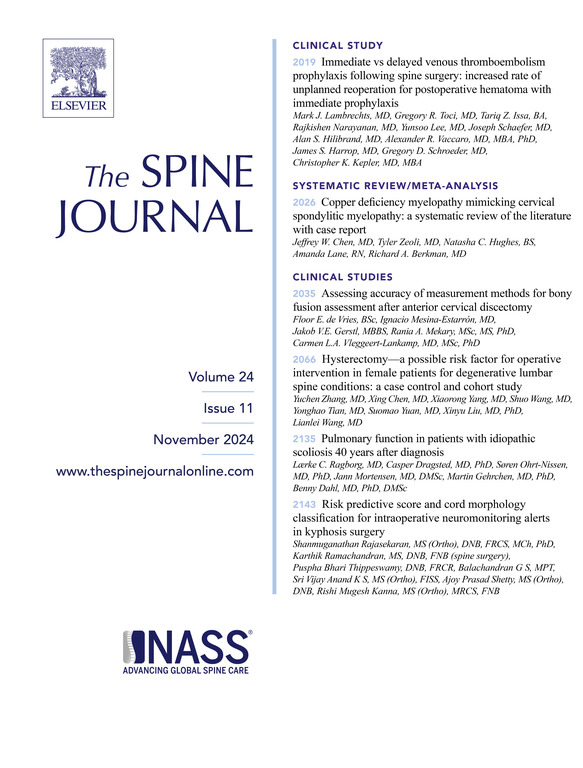Potential causes of iatrogenic intraoperative bleeding during C1 surgeries: a CT 3D rendering study
IF 4.9
1区 医学
Q1 CLINICAL NEUROLOGY
引用次数: 0
Abstract
BACKGROUND
Iatrogenic intraoperative bleeding during C1 surgeries is difficult to manage.
PURPOSE
To investigate the potential causes of iatrogenic intraoperative bleeding in atlas surgeries.
STUDY DESIGN
This was a retrospective study, observational cohort of patients with DICOM.
PATIENT SAMPLE
High-resolution head and neck computed tomography angiography (CTA) images from 551 subjects were included.
OUTCOME MEASURES
Ponticulus posticus (POPO), vertebral artery (VA), venous plexus communication.
METHODS
Three dimension rendering was utilized in the present study. Potential arterial bleeding was evaluated based on the variation in the VA and the polymorphism of the POPO over the groove for VA (GVA). The communication of the venous plexus in the occipitoatlantal region was investigated to assess the venous hemorrhage.
RESULTS
Among the 551 atlases examined, POPOs were identified on 155 sides, resulting in a prevalence of 14.07% (155/1102). These POPOs (n=155) were reclassified into four types: tiny spur (54.84%), long spur (7.10%), ossified bridge (30.32%), and ossified canal (7.74%). In 42.92% (473/1102) of cases, the VA did not directly contact the sulci of the GVA, creating space for the passage of the rich venous plexus that drained intracranial venous blood outflow to various extracranial layers. Moreover, in 12.7% of the subjects, the study revealed the presence of additional foramens in the posterior lamina of C1, which served as a conduit for the communicating vein
CONCLUSION
The potential underestimation of polymorphism in POPOs and VAs can lead to arterial bleeding, whereas a lack of understanding of the intricate condylar emissary venous plexus can result in venous hemorrhage. To mitigate iatrogenic hemorrhage during C1 surgeries, a preoperative HEAD AND NECK CTA is recommended, and heightened caution should be exercised during dissection in the lateral half of the C1 lamina. Furthermore, unknown causes of intraoperative bleeding may arise during the posterior C1 approach; modifications should be considered based on the specific circumstances encountered.
C1手术中医源性术中出血的潜在原因:CT 3D渲染研究。
背景:C1手术中医源性术中出血难以控制。目的:探讨寰椎手术中医源性出血的潜在原因。研究设计:这是一项针对DICOM患者的回顾性观察队列研究。患者样本:包括551名受试者的高分辨率头颈部计算机断层血管造影(CTA)图像。观察指标:后ponticus (POPO),椎动脉(VA),静脉丛通讯。方法:采用三维绘制技术。根据VA的变化和VA沟上POPO的多态性来评估潜在的动脉出血。观察枕寰区静脉丛的连通性以评估静脉出血。结果:在551个地图集中,有155侧发现了popo,患病率为14.07%(155/1102)。这些popo (n = 155)被重新划分为4种类型:小骨刺(54.84%)、长骨刺(7.10%)、桥骨化(30.32%)和管骨化(7.74%)。在42.92%(473/1102)的病例中,外静脉没有直接接触外静脉的沟,为丰富的静脉丛的通过创造了空间,将颅内静脉血流出引流到颅外各层。此外,在12.7%的受试者中,研究发现C1后板存在额外的孔,作为交通静脉的导管。结论:对popo和VAs多态性的潜在低估可导致动脉出血,而缺乏对复杂的髁窦静脉丛的了解可导致静脉出血。为了减轻C1手术期间的医源性出血,建议术前进行头颈部CTA,并且在C1侧半层板剥离时应高度谨慎。此外,在C1后入路中可能出现不明原因的术中出血;应根据遇到的具体情况考虑修改。
本文章由计算机程序翻译,如有差异,请以英文原文为准。
求助全文
约1分钟内获得全文
求助全文
来源期刊

Spine Journal
医学-临床神经学
CiteScore
8.20
自引率
6.70%
发文量
680
审稿时长
13.1 weeks
期刊介绍:
The Spine Journal, the official journal of the North American Spine Society, is an international and multidisciplinary journal that publishes original, peer-reviewed articles on research and treatment related to the spine and spine care, including basic science and clinical investigations. It is a condition of publication that manuscripts submitted to The Spine Journal have not been published, and will not be simultaneously submitted or published elsewhere. The Spine Journal also publishes major reviews of specific topics by acknowledged authorities, technical notes, teaching editorials, and other special features, Letters to the Editor-in-Chief are encouraged.
 求助内容:
求助内容: 应助结果提醒方式:
应助结果提醒方式:


